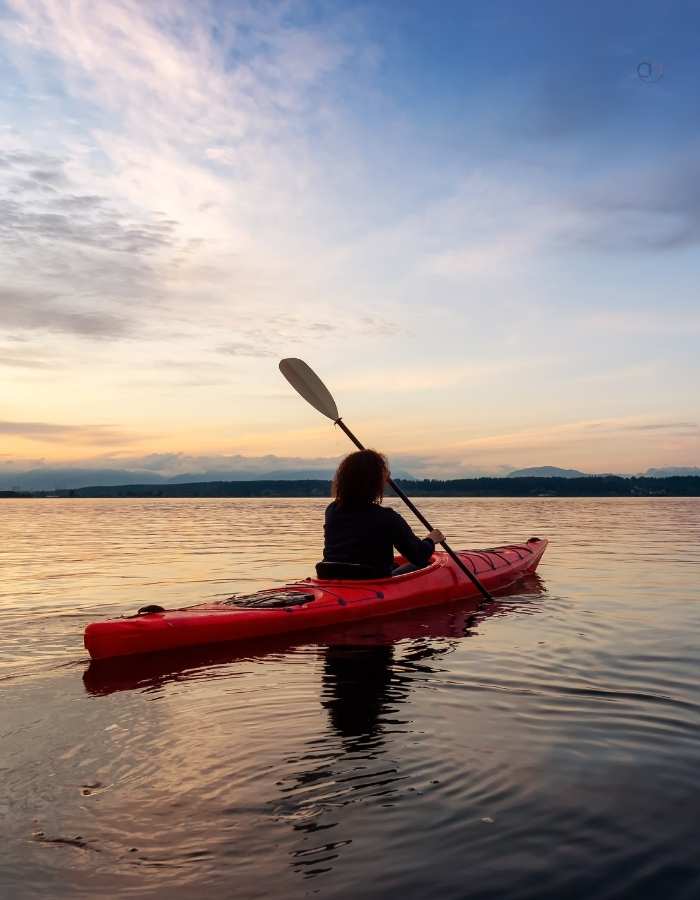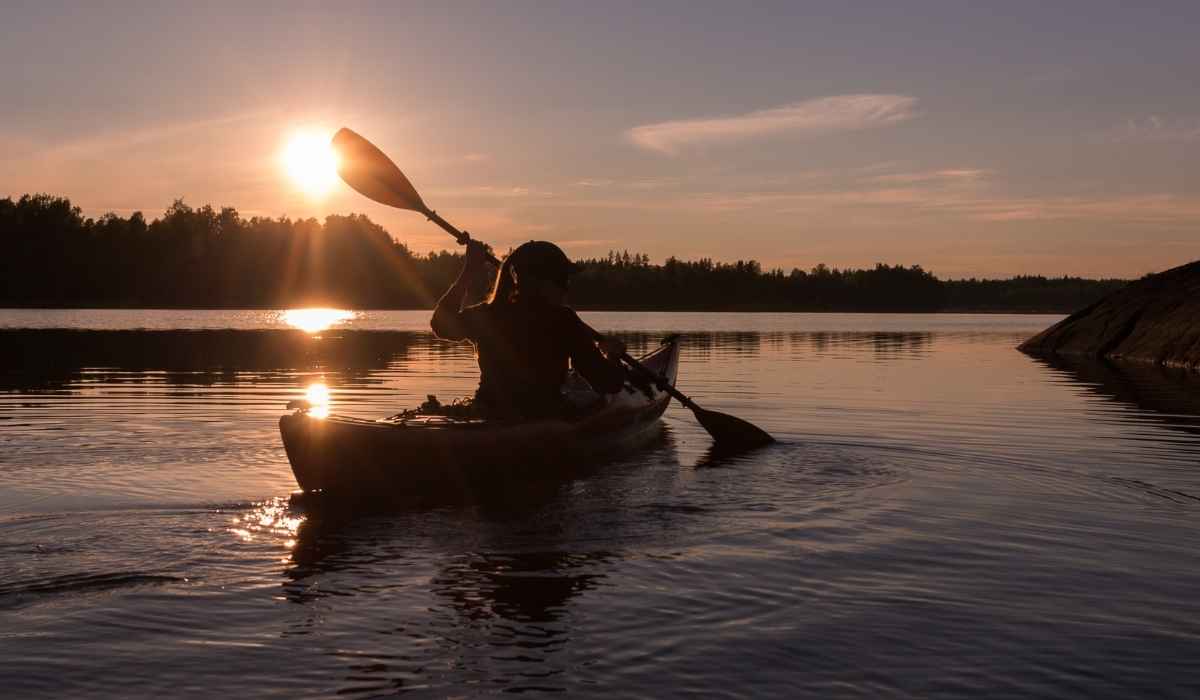Is kayaking easy for beginners?
Thinking about giving kayaking a try but unsure if it’s suitable for beginners? The good news is that kayaking is a fun and accessible activity for newcomers!
If you’re paddling on a calm lake, a gentle river, or along a peaceful coastline, kayaking can be an incredibly rewarding experience with the right approach.
While it may seem intimidating at first, with a little practice and guidance, you’ll feel at ease on the water in no time.
Get full guide you through what to expect as a beginner, share helpful tips for your first kayaking adventure, and show you how to make the most of your experience on the water.
What Is Kayaking?
TOC

Kayaking involves paddling a small boat, known as a kayak, with a double-bladed paddle. Unlike canoes, which typically have a single-bladed paddle and an open top, kayaks are either partially or fully enclosed, offering greater stability and efficiency. The main goal is to use your paddle to propel the kayak forward, using coordinated movements of your arms and torso to glide through the water.
Types of Kayaks:
There are several types of kayaks, each designed for specific purposes. Understanding the differences can help you choose the right one for your needs.
- Sit-on-Top Kayaks: These are perfect for beginners. You sit on top of the kayak, making them easy to get into and more stable, especially in calm waters. They’re ideal for leisurely paddling on lakes, rivers, or gentle coastlines.
- Sit-Inside Kayaks: These kayaks feature an enclosed cockpit where you sit inside. They are great for cooler weather and offer more protection but require more skill to balance and maneuver.
- Touring Kayaks: Designed for longer trips on open waters, touring kayaks are longer and more streamlined. While they’re suited for experienced paddlers, they provide a comfortable and fast ride for those looking to explore more challenging waters.
- Whitewater Kayaks: These short, agile kayaks are made for navigating rapids and rough waters. They’re best for experienced kayakers due to the high level of skill required.
- Recreational Kayaks: Typically wider and more stable, these are designed for short paddles in calm, protected waters. They are the perfect choice for beginners who want to enjoy a relaxed day on the water.
Essential Kayaking Terms:
To feel more comfortable on the water, it helps to know some basic kayaking terminology:
- Paddle: The tool you use to move the kayak, featuring two blades (one at each end).
- Stroke: The action used to propel the kayak forward or backward. There are different strokes, including the forward stroke (to move forward), reverse stroke (to move backward), and sweep stroke (to turn).
- Hull: The body or bottom of the kayak, which determines how it sits in the water. Kayaks vary in shape to optimize speed, stability, and maneuverability.
- Cockpit: The enclosed area in a sit-inside kayak where you sit. The cockpit is often sealed with a spray skirt to prevent water from entering.
- Bow and Stern: The front (bow) and rear (stern) of the kayak. Knowing these terms will help you communicate better with other paddlers.
Basic Paddling Techniques:
Once you’re in your kayak, learning how to paddle effectively is key to moving efficiently and enjoying the experience. Here are the basic techniques to get you started:
- Forward Stroke: Sit upright and hold the paddle with both hands. Submerge one blade in the water near your feet, and pull it back toward your hip. Repeat the motion on the other side to move forward.
- Reverse Stroke: To move backward, reverse the forward stroke by pushing the paddle forward instead of pulling it back.
- Sweep Stroke: To turn, dip the paddle blade into the water near the front of the kayak (bow) and sweep it in a wide arc toward the rear (stern). This helps you change direction smoothly without losing momentum.
- Edging: Lean the kayak slightly to one side to help with turning or navigating rough water. This is a great technique for gaining better control.
Safety and Comfort Tips:
Before you set off on your kayaking adventure, remember these important safety and comfort tips:
- Wear a Life Jacket: Always wear a life jacket or personal flotation device (PFD). It’s not only a safety requirement in many places, but it will keep you afloat if you tip over.
- Dress Appropriately: Wear lightweight, moisture-wicking clothing for warmth and comfort. If paddling in cold weather, bring waterproof gear to stay dry.
- Check Weather Conditions: Always check the weather forecast before heading out. Avoid kayaking in rough conditions, like strong winds or thunderstorms, especially as a beginner.
- Start in Calm Waters: Begin your kayaking journey on calm, sheltered waters—lakes or slow-moving rivers are perfect for building your confidence and skills.
is kayaking easy for beginners:
If you’re thinking about trying kayaking but wondering whether it’s an easy activity to pick up as a beginner, you’re in the right place. Let’s take a closer look at why kayaking is accessible for beginners and how you can make the most of your first kayaking adventure.
1. Kayaking Is Simpler Than It Appears
At first, kayaking might seem complicated—there are paddles, strokes, and balance to consider. However, the basic concept of kayaking is straightforward: you sit in a kayak and use a double-bladed paddle to move yourself through the water. While mastering advanced techniques takes time, getting started is much easier than it seems. In fact, most beginners can start paddling and feeling comfortable after just a short lesson.
2. Choosing the Right Kayak for Beginners
The type of kayak you use can make a big difference in how easy kayaking is for you. Sit-on-top kayaks are the most beginner-friendly option. They are stable, easy to get in and out of, and ideal for calm waters like lakes or slow-moving rivers. These kayaks are perfect for newbies who want to get comfortable with the basics of paddling without worrying too much about tipping over.
Alternatively, sit-inside kayaks are a bit more enclosed and offer more protection, but they can be trickier to balance for those new to kayaking. For a beginner, starting with a sit-on-top kayak will likely make the experience more enjoyable and less stressful.
3. Start in Calm, Protected Waters
To ease into kayaking, it’s best to begin in calm and sheltered waters. Lakes, peaceful rivers, and sheltered coastlines are the perfect settings for beginners to practice their skills without the added challenge of strong currents or waves. Starting out in these conditions allows you to focus on mastering the basics, like paddling and steering, without feeling overwhelmed.
As you gain confidence, you can move on to more challenging waters, but for your first few trips, keep it simple and stick to calm, flat water.
4. Safety Comes First
One of the key elements to making kayaking easy and enjoyable for beginners is prioritizing safety. Always wear a life jacket (also known as a personal flotation device or PFD). Even if you’re a strong swimmer, it’s essential to stay safe on the water. Many places require life jackets by law, and they will keep you afloat in case you capsize.
Also, check the weather forecast before you head out, and avoid kayaking if conditions are unfavorable—such as strong winds, storms, or rough water. Understanding your limits and paddling in safe conditions will help ensure you have a positive experience.
5. Basic Paddling Techniques Are Easy to Learn
You don’t need to be an expert to start kayaking. The basic paddling techniques are simple and easy to pick up. The two most important strokes to learn are the forward stroke and the reverse stroke. The forward stroke moves you ahead, and the reverse stroke helps you stop or move backward.
Additionally, the sweep stroke is useful for turning the kayak. This involves sweeping the paddle in a wide arc to steer the boat. These basic strokes will get you moving and allow you to control your kayak with ease.
6. Practice Makes Perfect
Like any new skill, kayaking becomes easier with practice. Your first time on the water might feel a little awkward as you get used to the motion and balance. But don’t worry—this is normal. After a little while, you’ll get the hang of it. The more you paddle, the more natural it will feel. Most beginners find that after an hour or two on the water, they’re already feeling more comfortable and confident.
7. Kayaking is Fun and Enjoyable for Everyone
One of the great things about kayaking is that it’s an activity anyone can enjoy, regardless of skill level. It’s more about having fun and soaking in the natural beauty around you than about performing perfectly. As a beginner, you’ll likely experience the joy of gliding through the water while connecting with nature—whether you’re paddling across a serene lake or along a river.
Kayaking is an incredibly relaxing way to spend time outdoors, and most beginners quickly realize that it’s as much about the peaceful experience as it is about mastering the paddle.
Grab your life jacket, paddle, and kayak, and get ready for a great adventure!
Read Next: How To Sail A Boat
Common Mistakes Beginners:
we’ll look at the most frequent mistakes made by beginner kayakers—and share practical tips on how to steer clear of them.
1. Overexerting Yourself
A frequent mistake beginners make is trying to paddle too hard or for too long, especially in the beginning. Overexerting yourself can quickly lead to fatigue, which makes kayaking less enjoyable and can even cause discomfort or injury.
How to Avoid It: Start slow and keep a relaxed pace when you’re learning the ropes. Focus on technique rather than speed. Take breaks as needed, and remember, kayaking is meant to be a leisurely experience. Pacing yourself will help you build endurance over time and enjoy the activity without exhausting yourself.
2. Poor Posture
Many beginners struggle with proper posture, either hunching their back or sitting too rigidly. This not only makes paddling harder but can also lead to discomfort or strain over time.
How to Avoid It: Sit up straight with your back aligned and shoulders relaxed. Your feet should be positioned on the footrests, with your knees slightly bent for balance. Engage your core muscles to help with the paddling motion, and remember to use your whole body, not just your arms, to push the paddle. Good posture improves comfort and paddling efficiency.
3. Gripping the Paddle Too Tightly
Beginners often grip the paddle too tightly in an effort to maintain control. This can lead to hand fatigue, muscle strain, and less control over your strokes.
How to Avoid It: Hold the paddle gently but securely. Keep your grip relaxed, allowing your hands and wrists to move freely. A loose grip reduces strain on your muscles and helps you paddle more fluidly. Focus on controlling the paddle with your whole body, rather than using only your hands.
4. Not Paying Attention to the Water
Some beginners get so focused on their technique or their surroundings that they forget to keep an eye on the water. This can lead to accidents, such as hitting obstacles or misjudging currents.
How to Avoid It: Stay aware of your surroundings, including any changes in water conditions, such as current shifts or obstacles. Before heading out, familiarize yourself with the water and the area you plan to kayak in. Pay attention to local conditions, especially in rivers or coastal areas where currents can be unpredictable.
5. Skipping Safety Gear
Many newcomers think they don’t need safety gear because they’re confident in their swimming abilities. However, safety gear—particularly a life jacket—is essential for everyone, regardless of swimming skills.
How to Avoid It: Always wear a properly fitted life jacket (personal flotation device) when kayaking. Even in calm waters, a life jacket provides an extra layer of security in case of an unexpected fall. Depending on the environment, consider wearing additional gear like a helmet for whitewater kayaking or water shoes for better grip.
6. Ignoring Proper Paddling Techniques
New paddlers sometimes paddle without using the correct techniques. This can lead to wasted energy, poor control, and even injury. Incorrect paddling techniques often become ingrained, making them harder to fix later.
How to Avoid It: Learn the basics of paddling, such as the forward stroke, reverse stroke, and sweep stroke for turning. Focus on using your torso and core muscles rather than relying only on your arms. Smooth, consistent strokes will help you move more efficiently and conserve energy, making kayaking more enjoyable.
7. Dressing Incorrectly
Many beginners overlook the importance of proper clothing, wearing cotton or inappropriate gear for the conditions. Wearing the wrong clothing can make you uncomfortable, especially if you get wet or the weather changes unexpectedly.
How to Avoid It: Dress for the conditions. Opt for moisture-wicking, quick-drying fabrics that keep you comfortable if you get splashed or wet. In cooler weather, bring layers and waterproof gear. A hat and sunglasses are also a good idea for sun protection. Be prepared for changes in weather so you can stay comfortable throughout your trip.
8. Not Checking Local Regulations and Weather
Another common mistake is failing to check local guidelines or weather forecasts before heading out. This can lead to kayaking in unsafe conditions or entering restricted areas without knowing.
With the right technique, safety gear, and awareness, you’ll be able to enjoy kayaking with confidence.
How to Progress:
Kayaking is an exciting and rewarding sport, but like any skill, it requires time, practice, and dedication to improve. Whether you’re just starting out or you’ve been paddling for a while and want to enhance your abilities, there are plenty of ways to level up your kayaking game. With the right approach and consistent effort, you can become a more confident and capable kayaker. Here’s how to progress in kayaking, step by step.
1. Start with Solid Basics
Before diving into advanced techniques, it’s crucial to have a strong grasp of the basics. Mastering essential skills such as proper paddling, steering, and balancing your kayak will set the foundation for more complex moves. Focus on key strokes like the forward stroke, reverse stroke, sweep stroke, and draw stroke until they become natural.
Progress Tip: Spend enough time practicing the basic techniques to build muscle memory. The better you are at the basics, the easier it will be to master new skills.
2. Build Strength and Endurance
Kayaking engages multiple muscle groups, particularly your core, arms, and shoulders. To paddle efficiently and for longer durations, it’s important to improve both strength and endurance. Off-water training, such as rowing, planks, and push-ups, will help you develop the power needed for kayaking.
Additionally, increasing your cardio will boost your stamina, enabling you to paddle for longer distances without tiring. A fitter body means more control over your kayak and more energy for challenging paddles.
Progress Tip: Incorporate full-body exercises like swimming and cycling into your routine to improve overall fitness and make paddling feel easier.
3. Learn to Navigate Different Water Conditions
To truly progress, you need to challenge yourself by kayaking in different environments. While calm lakes and slow rivers are great places to start, kayakers often find that the real excitement lies in navigating whitewater rapids, coastal waters, or open-water kayaking.
Here’s how to tackle various conditions:
- Whitewater: Start with class I or II rapids, learning how to brace, edge, and roll your kayak. Gradually move to more challenging rapids as your skills improve.
- Ocean: Begin in sheltered areas and then progress to more exposed waters, dealing with waves, tides, and stronger currents.
- Long-distance paddling: Practice paddling for extended periods, managing your speed and energy.
Progress Tip: Gradually move to more challenging waters as you gain confidence. Start with calm conditions and work your way up to more dynamic environments.
4. Refine Your Paddling Technique
As you get more comfortable with kayaking, it’s time to refine your paddling technique. Bad technique leads to inefficiency, exhaustion, and poor control. Focus on:
- Correct grip: Hold your paddle firmly but not too tightly to avoid hand strain.
- Body movement: Paddle with your torso, not just your arms. Engage your core for better propulsion.
- Fluid strokes: Aim for smooth, consistent strokes to avoid unnecessary drag.
- Proper blade angle: Make sure your paddle blade is fully submerged at the correct angle for maximum power.
Progress Tip: Observe your form while paddling, or even record yourself to identify areas for improvement. Small adjustments to your stroke can have a big impact.
5. Improve Your Turning and Maneuvering Skills
Being able to turn and maneuver your kayak effectively is essential, especially when you’re kayaking in more challenging conditions. Practice turning using sweep strokes (wide, arching strokes) and use draw strokes to move the kayak sideways.
Learn edging (tilting the kayak to sharpen turns) to improve your ability to maneuver quickly and efficiently, especially in tight spaces or when navigating obstacles.
Progress Tip: Start by practicing turns in calm water and gradually progress to more challenging environments. The more you practice, the easier it will be to make precise, controlled movements.
6. Learn to Roll Your Kayak
A critical skill for any kayaker, especially in moving water, is the roll. If you capsize, being able to roll your kayak back upright will allow you to stay safe and continue paddling without needing to get out of the boat.
Start by practicing a wet exit (how to safely leave your kayak when it flips over) and then move on to learning how to roll. You can practice rolling in controlled settings like pools before attempting it in open water or moving rivers.
Progress Tip: Practice with a buddy or instructor, especially when learning the roll. Being in a safe environment is crucial until you feel confident enough to try it in more challenging conditions.
7. Take Lessons from a Professional
Even if you’ve been kayaking for a while, working with a certified instructor can make a huge difference in your progression. Instructors can provide personalized feedback, teach you advanced techniques, and help you refine your form. They can also introduce you to new kayaking disciplines, such as sea kayaking, whitewater kayaking, or kayak surfing.
Progress Tip: Enroll in a course or take private lessons to focus on specific areas you want to improve. Professional guidance can significantly accelerate your learning curve.
8. Set Specific Goals and Track Your Progress
Progress in kayaking isn’t just about hitting milestones—it’s about setting clear, actionable goals. Whether you aim to paddle a certain distance, master a new stroke, or kayak in more challenging waters, having goals will keep you motivated.
Track your progress after each session by reflecting on what you learned, what went well, and what needs improvement. Celebrating small victories will help you stay on track and continue moving forward.
Progress Tip: Break down larger goals into smaller, achievable steps. Track your achievements and focus on improvement rather than perfection.
Improving at kayaking takes time and consistent effort, but the rewards are well worth it. The key to progression is patience—continue to practice, stay safe, and, most importantly, enjoy the experience. As you challenge yourself, you’ll notice significant improvement in your skills, and the joy of kayaking will continue to grow.
Last Call:
Is kayaking easy for beginners?
- Kayaking is a fun and rewarding activity for beginners, but like any new skill, it requires a little practice and patience.
- While it’s not overly difficult, mastering basic paddling techniques and getting comfortable on the water takes time.
- Start on calm lakes or rivers, use the right gear, and focus on learning essential skills like controlling your paddle, steering, and safety.
- With gradual progress, you’ll soon find that kayaking is not only easy but an enjoyable way to explore the outdoors.
Call to Action:
- Ready to get started?
- Subscribe to our newsletter for expert kayaking tips, safety advice, and inspiration, and check out our Pinterest for more beginner guides and beautiful kayaking spots.
- Let’s paddle!
FAQs | is kayaking easy for beginners
Q. which kayak is best for beginners?
For beginners, recreational kayaks are an excellent choice. They’re stable, easy to handle, and perfect for calm water activities like lakes or slow rivers. Look for models with a wide, flat hull for increased stability. Sit-on-top kayaks are also great as they offer easy entry and exit, making them a top pick for newbies.
Q. what kind of kayak should i get?
The right kayak depends on your planned use. If you’re paddling on calm waters, a recreational kayak or sit-on-top kayak is ideal. For more specialized activities like whitewater or sea kayaking, you’ll need a kayak designed for those specific environments. Consider your comfort level, intended use, and water conditions when choosing.
Q. Is a life jacket necessary while kayaking?
Absolutely! A life jacket (also called a Personal Flotation Device, or PFD) is crucial for safety, no matter your experience level. It’s often required by law, and it ensures you stay afloat if you fall into the water unexpectedly.
Q. How difficult is it to learn kayaking?
Kayaking is relatively easy to learn, especially in calm waters. Most beginners can get the hang of basic paddling, steering, and balancing in just a few hours. With regular practice, you’ll improve quickly and gain confidence on the water.
Q. What should I wear when kayaking?
Opt for quick-drying, moisture-wicking clothes like synthetic fabrics or nylon. Avoid cotton, as it retains water and can make you cold. In cooler weather, wear waterproof layers and accessories like gloves or a hat to stay warm and dry.
Q. How do I control and steer my kayak?
To steer, use sweep strokes (wide, curved strokes) to turn your kayak. For finer control, alternate your forward strokes on each side to adjust direction. A reverse stroke can help you stop or back up. Practice these basic strokes to improve your handling skills.

Its Aliza R. Khan, a passionate travel blogger from Bangladesh. With a knack for inspecting hidden gems and sharing travel tips, I love to inspires readers to explore the world with curiosity and adventure.










